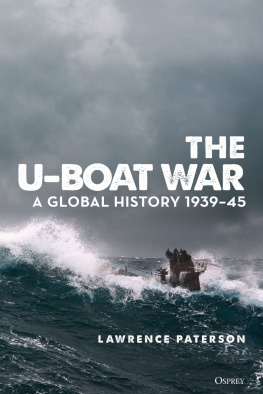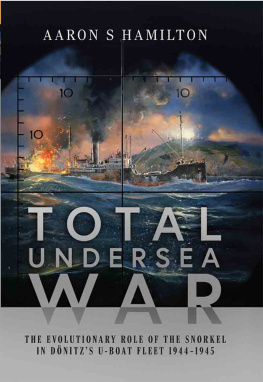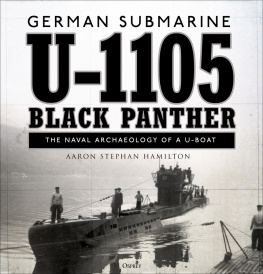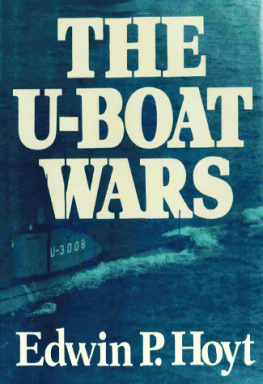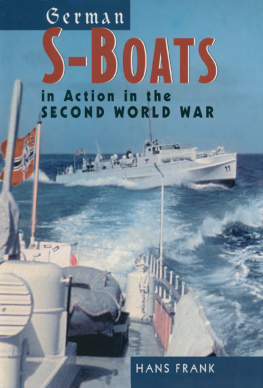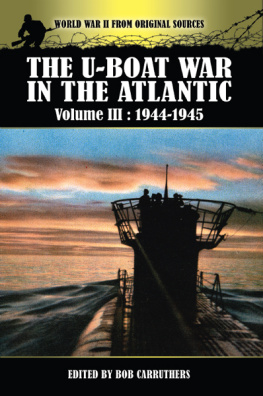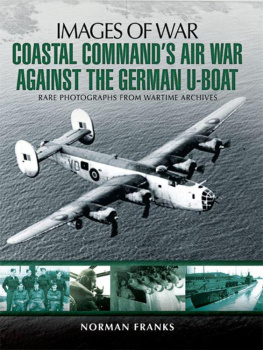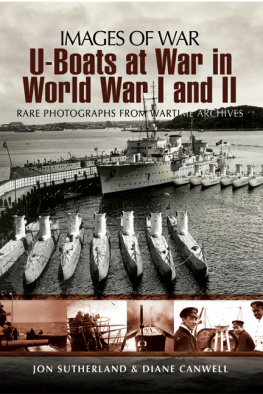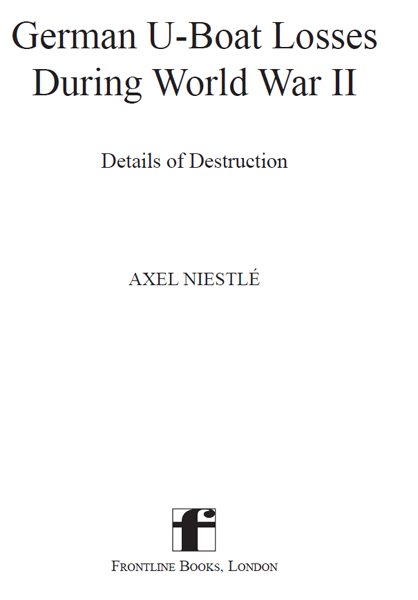

German U-Boat Losses During World War II: Details of Destruction
This edition published in 2014 by Frontline Books,
an imprint of Pen & Sword Books Ltd,
47 Church Street, Barnsley, S. Yorkshire, S70 2AS
www.frontline-books.com
Copyright Axel Niestl, 2014
The right of Axel Niestl to be identified as the author of this work has been asserted by him in accordance with the Copyright, Designs and Patents Act 1988.
ISBN: 978-1-84832-210-3
eISBN: 9781473838291
All rights reserved. No part of this publication may be reproduced, stored in or introduced into a retrieval system, or transmitted, in any form, or by any means (electronic, mechanical, photocopying, recording or otherwise) without the prior written permission of the publisher. Any person who does any unauthorized act in relation to this publication may be liable to criminal prosecution and civil
claims for damages.
CIP data records for this title are available from the British Library
For more information on our books, please visit
www.frontline-books.com, email info@frontline-books.com
or write to us at the above address.
Printed and bound by CPI Group (UK) Ltd, Croydon, CR0 4YY [TBC]
Typeset in 8.5/10.2 point Times New Roman by JCS Publishing Services Ltd
CONTENTS
LIST OF ILLUSTRATIONS
PREFACE
Why do we need another book on the whereabouts of the German U-boat fleet during World War II? As early as 1946, the basic data had been presented to the public in the official loss lists of the British Admiralty and the Office of the U.S. chief of naval operations, Navy Department. During the following five decades, several authors have also published in varying detail on this particular subject in the history of naval warfare.
The idea for it originated when I became aware that many of the wartime or postwar assessments on the loss of German U-boats were sometimes startlingly wrong. Wondering if other printed and published information was incorrect, I started a systematic check of all U-boat losses by using the existing German and Allied wartime records. This effort was greatly supported by the Naval Historical Branch of the British Ministry of Defence. In the end, the joint effort resulted in the reassessment of almost one-fifth of all front-line U-boat losses during the war with several others still under consideration.
With respect to the total number of U-boats, the tabular presentation of the data in abbreviated form offers the only way to limit the overall size of a book on the subject. My previous experience from having worked through the great amount of literature focusing on German U-boat operations and losses during World War II greatly helped to define the standard for its content and outline. The addition of background information on the individual U-boat provides a more complete set of facts on its last patrol and final fate. Extensive indexes were prepared to allow cross referencing and a quick search for specific data.
It is my hope that this volume will provide a handy compilation of updated information on the particulars of destruction of the German U-boats for future researchers and naval enthusiasts. It is certain that despite all my efforts to find the truth, there will remain a number of mistakes in the book for which the editors and the publisher cannot be blamed. I would appreciate any necessary corrections and additions to update the present information.
The completion of the book in its present form would not have been possible without the help of others. First of all, I would like to thank Robert M. Coppock of the Foreign Documents Section of the Naval Historical Branch of the British Ministry of Defence for exchanging the results of his work with me and for his willingness to discuss various cases. Credit belongs to the NHB and Coppocks work for a large number of reassessments of operational losses. I am greatly indebted to them for allowing this information to be included here.
Next I wish to thank Walter Cloots, Herentals, Belgium, for his lasting support. Without his relentless search for hitherto unnoticed records in various archives and institutions in Europe, the book would have been lacking much important information.
Flight Lieutenant (Ret.) Edmund Eddie Cheek, DSO, Barnstaple, Great Britain, generously provided his research on the achievements of the RAF Coastal Command during the war. I am also thankful to him for providing detailed insights into the Coastal Command procedure of anti-U-boat operations.
Herbert Ritschel, a long-time fellow in the research of the German U-boat operations, helped with important background data necessary for my research on individual U-boat losses.
Eberhard Rler, author of many publications on the history of German U-boat design and construction, helped to define the general standard for my own research during our numerous discussions. His kind offer to allow me free access to his materials during the last decade is reflected here in many details on individual losses.
Among those persons and institutions who also provided necessary information on various aspects of the subject of U-boat losses, I am grateful to (alphabetically) David J. Lees, Romfield, Great Britain; Lennart Lindberg, Stockholm, Sweden; Lt. Comdr. Doug MacLean (RCN), Ontario, Canada; Dr. Snke Neitzel, Mainz, Germany; Dr. Jrgen Rohwer, Weinheim, Germany; Dr. Roger Sarty, Directorate of History and Heritage, National Defence Headquarters, Ottawa, Canada; K. Kapt. (Ing) a.D. Klaus Schle, Kiel, Germany; Stiftung Traditionsarchiv Unterseeboote e.V., Cuxhaven, Germany and Peter J. White, Maidenhead, Great Britain.
Special thanks go to the Public Record Office, London; the National Archives, Washington D.C.; the former Militrarchiv of the German Democratic Republic, Potsdam; the Bundesarchiv/Militrarchiv, Freiburg, Germany and the Air Photo Library at the University of Keele, Great Britain, for providing many of the official records and materials used in the research.
I also would like to thank all former servicemen of the U-boat arm of the German Kriegsmarine who shared with me their memories on the fate of many U-boats scuttled or destroyed in the final days of the war along the coasts of the North Sea and the Baltic.
Most important, I wish to thank my wife Katrin and my children for their patience and understanding during the long periods of my absence from our family life while I was working on the book. Without their support and encouragement the completion of this work would have been impossible.
PREFACE TO THE SECOND EDITION
Research into the final fate of German U-boats operating on all seven oceans during World War II seems to be a never-ending story. It is now a well-established fact that many of the immediate postwar assessments by the British Admiralty and its US counterpart were outright wrong. The work to correct previous mistakes has been carried on since the publication of the first edition of this book in 1998. The sheer number of changed U-boat fates and the fact that the first edition had been sold out for a long time, warrants a second edition of this work sixteen years later. Hence, I was very thankful for the offer from the publisher to prepare this updated and corrected edition of my work.
Much to my disappointment, the number of German U-boats still recorded as missing at this time could not be reduced significantly, despite all efforts to uncover their final fates. Although a number of long-standing mystery losses were finally solved, other wartime assessments had to be revised without finding out the real reasons for the relevant losses. Thus, there are still sixty-three boats at present which are recorded as missing or whose final fate has not been fully ascertained. It seems more than likely that a fair number of them were lost to human or material failure in the absence of enemy forces, while others may have succumbed to attacks without providing visual evidence of their destruction. The answer in all this cases is still hidden in the sometimes confusing wartime actions or the darkness of the oceans. However, from the new assessments it has been established that Allied sea mines were far more effective U-boat killers during the final inshore campaign around the British Isles in 1944/45 than previously known. In combination with many other reassessments within this period of the U-boat campaign, previous accounts on the operational history of the last phase of the German U-boat war must be rewritten in many cases.


